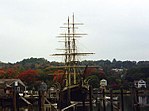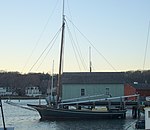Charles W. Morgan (ship)
Historic district contributing properties in ConnecticutMMSI NumberMuseum ships in Mystic, ConnecticutNRHP infobox with nocatNational Register of Historic Places in New London County, Connecticut ... and 4 more
Ships built in New Bedford, MassachusettsShips on the National Register of Historic Places in ConnecticutTall ships of the United StatesWhaling ships

Charles W. Morgan is an American whaling ship built in 1841 that was active during the 19th and early 20th centuries. Ships of this type were used to harvest the blubber of whales for whale oil which was commonly used in lamps. Charles W. Morgan has served as a museum ship since the 1940s and is now an exhibit at the Mystic Seaport museum in Mystic, Connecticut. She is the world's oldest surviving (non-wrecked) merchant vessel and the only surviving wooden whaling ship from the 19th century American merchant fleet (of an estimated 2,700 built). The Morgan was designated a National Historic Landmark in 1966.
Excerpt from the Wikipedia article Charles W. Morgan (ship) (License: CC BY-SA 3.0, Authors, Images).Charles W. Morgan (ship)
Greenmanville Avenue,
Geographical coordinates (GPS) Address Website Nearby Places Show on map
Geographical coordinates (GPS)
| Latitude | Longitude |
|---|---|
| N 41.362788888889 ° | E -71.965247222222 ° |
Address
Mystic Seaport Marine Museum
Greenmanville Avenue 75
06355
Connecticut, United States
Open on Google Maps











